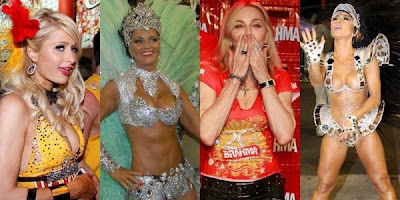 CARNAVAL - História do Carnaval !O carnaval é considerado uma das festas populares mais animadas e representativas do mundo. Tem sua origem no entrudo português, onde, no passado, as pessoas jogavam uma nas outras, água, ovos e farinha. O entrudo acontecia num período anterior a quaresma e, portanto, tinha um significado ligado à liberdade. Este sentido permanece até os dias de hoje no Carnaval.O entrudo chegou ao Brasil por volta do século XVII e foi influenciado pelas festas carnavalescas que aconteciam na Europa. Em países como Itália e França, o carnaval ocorria em formas de desfiles urbanos, onde os carnavalescos usavam máscaras e fantasias. Personagens como a colombina, o pierrô e o Rei Momo também foram incorporados ao carnaval brasileiro, embora sejam de origem européia.
CARNAVAL - História do Carnaval !O carnaval é considerado uma das festas populares mais animadas e representativas do mundo. Tem sua origem no entrudo português, onde, no passado, as pessoas jogavam uma nas outras, água, ovos e farinha. O entrudo acontecia num período anterior a quaresma e, portanto, tinha um significado ligado à liberdade. Este sentido permanece até os dias de hoje no Carnaval.O entrudo chegou ao Brasil por volta do século XVII e foi influenciado pelas festas carnavalescas que aconteciam na Europa. Em países como Itália e França, o carnaval ocorria em formas de desfiles urbanos, onde os carnavalescos usavam máscaras e fantasias. Personagens como a colombina, o pierrô e o Rei Momo também foram incorporados ao carnaval brasileiro, embora sejam de origem européia. No século XX, o carnaval foi crescendo e tornando-se cada vez mais uma festa popular. Esse crescimento ocorreu com a ajuda das marchinhas carnavalescas. As músicas deixavam o carnaval cada vez mais animado.
A primeira escola de samba surgiu no Rio de Janeiro e chamava-se Deixa Falar. Foi criada pelo sambista carioca chamado Ismael Silva. Anos mais tarde a Deixa Falar transformou-se na escola de samba Estácio de Sá. A partir dai o carnaval de rua começa a ganhar um novo formato. Começam a surgir novas escolas de samba no Rio de Janeiro e em São Paulo. Organizadas em Ligas de Escolas de Samba, começam os primeiros campeonatos para verificar qual escola de samba era mais bonita e animada.
O carnaval de rua manteve suas tradições originais na região Nordeste do Brasil. Em cidades como Recife e Olinda, as pessoas saem as ruas durante o carnaval no ritmo do frevo e do maracatu.
Os desfiles de bonecos gigantes, em Recife, são uma das principais atrações desta cidade durante o carnaval.
Na cidade de Salvador, existem os trios elétricos, embalados por músicas dançantes de cantores e grupos típicos da região. Na cidade destacam-se também os blocos negros como o Olodum e o Ileyaê, além dos blocos de rua e do Afoxé Filhos de Gandhi.
What it is The carnival is considered one of the livened up and representative popular parties more of the world. It has its origin in the Portuguese carnival, where, in the past, the people played one in the others, water, eggs and flour. The carnival happened in a previous period quaresma e, therefore, it had one meaning on to the freedom. This direction remains until the present in the Carnival. History of the Carnival The carnival arrived at Brazil for return of century XVII and was influenced by the carnavalescas parties that happened in the Europe. In countries as Italy and France, the carnival occurred in forms of urban parades, where the carnavalescos used masks and fancies. Personages as the colombina, pierrô and King Momo had been also incorporated the Brazilian carnival, even so are of European origin. In Brazil, in the end of century XIX, they start to appear the first carnavalescos blocks, laces and the celebrities " corsos". These last ones, had become more popular in the start of centuries XX. The people if fantasiavam, decorated its cars and, in groups, they paraded for the streets of the cities. It is the origin of the alegóricos, typical cars of the current schools of samba there. In century XX, the carnival was growing and becoming each time plus a popular party. This growth occurred with the aid of marchinhas carnavalescas. Musics left the carnival more each livened up time. The first school of samba appeared in Rio De Janeiro and was called Leaves To speak. It was created by the Carioca sambista called Ismael Silva. Years later Deixa To speak was changedded into the school of samba Estácio de Sá. From the street carnival it starts there to gain a new format. They start to appear new schools of samba in Rio De Janeiro and São Paulo. Organized in Leagues of Schools of Samba, the first championships start to verify which school of samba were prettier and livened up. Giant dolls in Recife The street carnival kept its original traditions in the Northeast region of Brazil. In cities as Recife and Olinda, the people leave the streets during the carnival in the rhythm frevo and maracatu. The parades of giant dolls, in Recife, are one of the main attractions of this city during the carnival. In the city of Salvador, the electric trios, packed for dançantes musics of singers exist and typical groups of the region. In the city the black blocks are also distinguished as the Olodum and the Ileyaê, beyond the blocks of street and of the Afoxé Children of Gandhi.